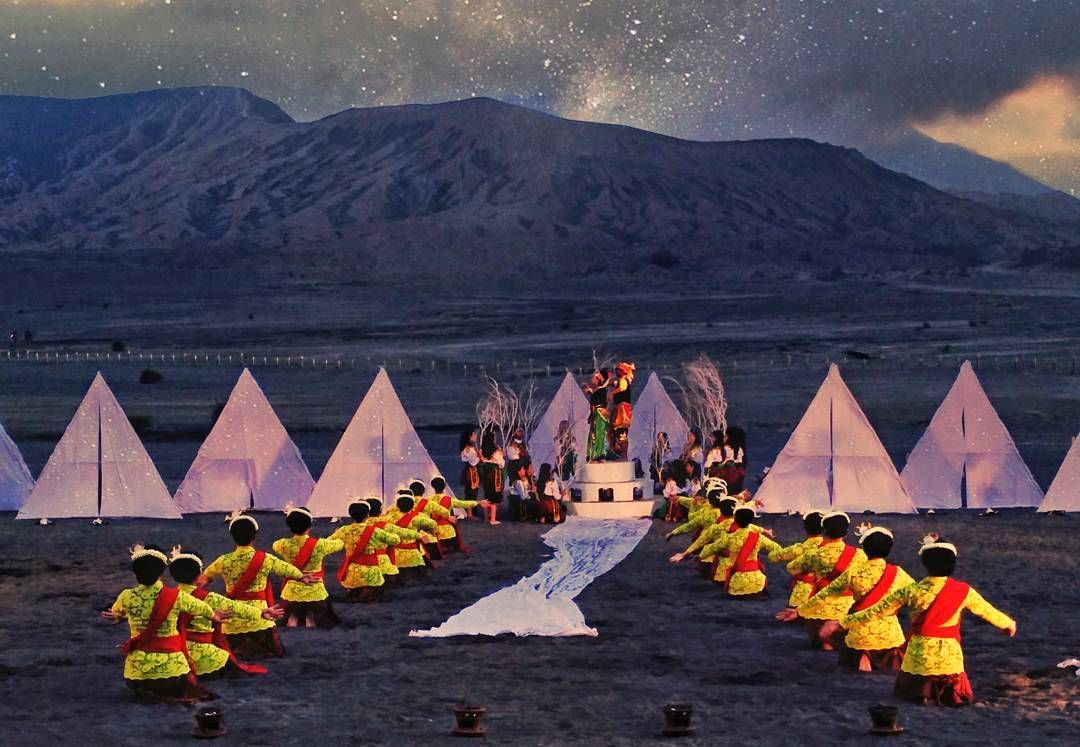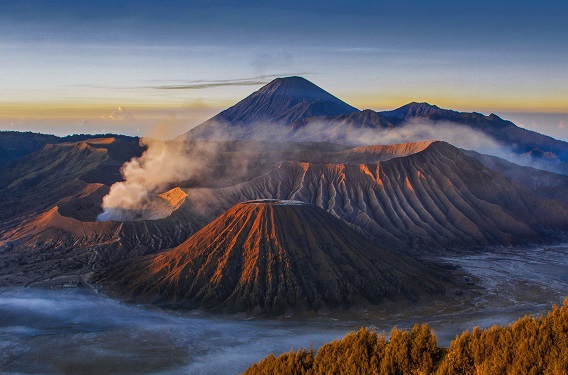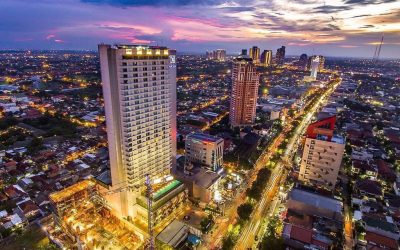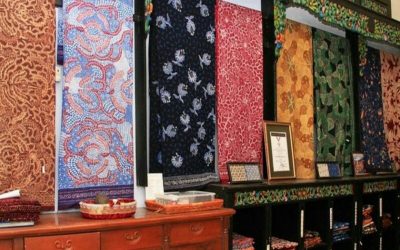Home / Batik Regions – Western Indonesia – Java Island – East Java / The Kasada Ceremony at Mount Bromo
Cultural Destination
Embrace the spirit of the place!
The Kasada Ceremony at Mount Bromo

Kasada Ceremony held in the slope of Bromo mountain (photo: @Nahroby)

Bromo Mountain (photo: Pesona Indonesia)
The Kasada Ceremony at Mount Bromo
The Kasada/Sukasada Ceremony is a traditional ceremony of the Tengger tribe. It is meant as a gratitude ritual and a memorial to the sacrifice of Raden Kesuma. The ritual is a means to ask for salvation by giving offerings to God and the ancestors. It is started with prayer chants and sacred dance performances by the local Tengger tribesmen and women on the sandy slopes of Mount Bromo, then concluded by throwing the various offerings prepared to the Mount’s crater.
Tourist Attractions in East Java
Surabaya City of Heroes
Indonesia’s heritage city that was built as a commemoration to soldiers lost to the Great War
East Java House of Batik
Do you want to see all variants of Batik motifs in East Java?
Trowulan – Majapahit Heritage Site
Rumor has it that after the death of a king or queen, many rites began to
East Java
Batik Motifs
Sekar Jati
Sekar means flower and Jati refers to teak trees that symbolizes a strong mental character that
Gedhog Kembang Waluh
a combination of Javanese cultural motif of the Majapahit kingdom (XII-XIV century) with
Discover
Indonesian
Batik
Motifs
Gamolan
This motif illustrates Gamolan, a bamboo musical instrument of Lampung that is
Daun Lada Hitam
The black pepper motif represents the main commodity of Bangka Belitung
Raja Ampat
Raja Ampat motif represents the marine life at Raja Ampat archipelago in
Pohon Hayat (Tree of Life)
The Batik motifs in Lampung are dominated by the acculturation of Buddhist and
Kaganga Tanah Rejang
If Batik Besurek combines Arabic calligraphy motifs, then the Kaganga batik takes
Karawo Pinang
Pinang refers to the Palm areca tree. This motif is considered as the original
Lipaq Sabe
Lipaq Saqbe contains a simple geometric classical motif with various flower decorations. This textile is
Leuit Sijimat
This motif reflects the daily activities of the Baduy tribe in Banten. The main ornaments of batik motif consist of:
Gonggong Beruntun
This motif illustrates that a person should maintain a positive attitude and
Tampuk Manggis Sasirangan
The motif illustrates the philosophy of the mangosteen fruit, which is
Honai
The Honai is inspired by the traditional house of the Papuan community living in
Kasih Tak Sampai
‘Kasih Tak Sampai’ is an idiom in the Indonesian language which refers to
Kain Cual
Cual textile tradition has existed since the 17th century. The word “Cual” refers to
Sido Mulyo
Sidomulyo is one of the classical motifs, which is specifically used for the bride’s costume in
Wirasat
Wirasat or divine inspiration is a gift from God. This inspiration is symbolized by
Durian Pecah
Broken Durian motifs depict the foundation of faith. The second half signifies the mastery of
Besurek Rembulan
This batik illustrates praise for God who created the wonderful universe
Tanah Liek
The word “Tanah Liek” refers to clay in Minang language. It is also known as
Bale Lumbu
This motif signifies the welfare of the ancient Sasak society. Bale also symbolizes the
Kawung
The Kawung motif was created by Sultan Agung Hanyokrokusumo (1593 – 1645) as a symbolic gift for
Gurdo Solo
Gurdo or garuda bird is the mount of the Indian god Vishnu. As the Sun Bird,
Tifa Totobuang
The batik motifs illustrate Maluku’s traditional music instrument called
Teguh Bersatu
This batik motif shows the strength of the people of Kupang. It also represents a sense of
Cengkeh
The clove flower motif is the main commodity of the Tolitoli Regency. This motif represents
Srimanganti
The name of the Srimanganti motif is derived from Palace’s hallway that connects to
Desa Na Tolu
The Desa Na Tolu characteristic pattern symbolizes the Batak philosophy of existence and
Salakanagara
Salakanagara batik motif illustrates the first kingdom in the Betawi land
Gorga Simeol-Meol
The Gorga Simeol-meol is a pattern of plant tendrils. it is regarded as a symbol of longevity and
Daun Simpor
This motif is inspired by the Simpor plant (Dillenia Suffruticosa) which is a typical
Tangerang Herang
Tangerang Herang motif is a symbol of Tangerang city. The Tangerang Herang batik motif consists of
Biji Kopi
The coffee seeds motif illustrates the pride of local coffee specialities in
Gonggong Siput
Gonggong (Strombus Turturella) is one type of sea snail found around
Tenun Bima
The motifs are adopted from Bima woven textile. This pattern has received a great
Prada Papua
The word “Prada” in the Javanese-Indonesian dialect means a batik textile that
Insang Ikan
Insang refers to the gills of the fish. This is a typical pattern of Malay ethnic who inhabits
Pala Salawaku
This motif illustrates the unique weapons of the Maluku region, namely
Besurek Rafflesia
The term “Basurek” refers to a textile that contains letters or inscriptions
Singayaksa
The Singayaksa motif comes from the name of a place where Sultan Hasanuddin used to
Tongkonan
Toraja’s traditional house is called Tongkonan. Tongkonan is a place for
Lontara
The Lontara script itself is a typical ancient script of Bugis and Makassar communities. History records that
Gajah Way Kambas
The motif illustrates the Lampung’s natural reserve, the Way Kambas. it also symbolizes
Ake Patra
Ake is related to the divinity and the composition of the universe. It is a symbol of
Ukir Sentani
The Ukir motif is a batik motif that is inspired by various traditional Sentani wood carvings
Jupri Kembang Teh
Kembang Teh illustrates the tendrils of tea plants that grow in the highlands of
Paqbarre Allo
The word “Barre” means round and “Allo” means the sunlight. This motif is interpreted as
Kuda Kupang
Horses symbolize wealth. It contains noble values of virtuous characters that bring
Tikar Natuna
The Tikar Natuna motif is adapted from the traditional making of pandanus mats in
Hiu Taliyasan
Indonesia is also home to the world’s largest fish, the whale shark (Rhincodon typus). Hiu Taliyasan refers to
Tabir Tanjung
Tanjung flower is a type of Cherry tree flower, which is commonly found in
Tubo Kelapa
Coconut tree is a symbol of a good character and strong mentality. It illustrates the more success a person, the more
Ikan tambal
The word “Ikan” refers to fish. The philosophical meaning of Ikan Tambal means is
Rangkiang
The word “Rangkiang” refers to the rice granary in the Minangkabau language. It symbolizes
Bekantan Pakis
This motif represents Pakis Haji (Polystichum setiferum), an endemic plant in
Pati-Pati Pinehiku
It symbolizes the hierarchy in society and the social status of the Mekongga
Keluak Daun Pakis
The word “Keluak” is a Minang language which means twisted or tangled. The Motif of
Sekomandi
Its philosophical meaning is the eternal union which refers to a saying “until death do us part”
Manguni Minahasa
Manguni is identified as the symbol of the Minahasa people. Manguni is known as a
Jumputan Bintang
The word Jumputan means the tie-dye technique, while the word “Bintang” refers to
Awan Berarak
Awan Berarak is a combination of Dayak motifs and Malay patterns. The word ‘Awan Berarak’ means the
Malinau Cultural Festival
You will witness a unique competition that might not be found other than in
Pucuk Rebung Riau
Pucuk Rebung symbolizes heart determination in achieving goals, good luck, and
Dayak Kamang
Kamang motif is generally found in the Dayak tribe shield because it is believed to
Parang Seling
Parang Seling or “alternating daggers” is a royal batik motif. It is a feminine variant of
Sero Tangga
The Sero Tangga illustrates an endearing feeling and sacrifices of a person to fulfil
Gedhog Kembang Waluh
a combination of Javanese cultural motif of the Majapahit kingdom (XII-XIV century) with
Wakatobi
It symbolizes the coastal beauty of the Wakatobi island and the symbol of Patra symbolizes
Buketan Bali
The Balinese bouquet (Buketan Bali) is a floral arrangement and the name is
Tengkawang Ampiek
With its many advantages, the Dayaks use this leaf in ritual ceremonies. This plant is a symbol of
Enggang Dayak
Local people beliefs that hornbills are an incarnation of the Commander of the Birds. It has supernatural
Daun Sirih
This motif illustrates betel leaves that are used by Lombok communities as traditional



